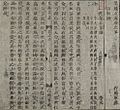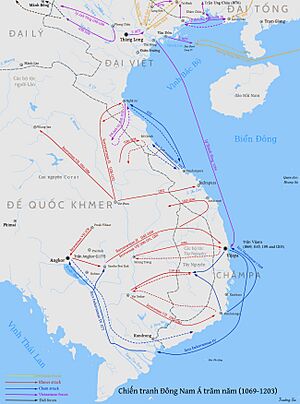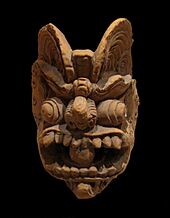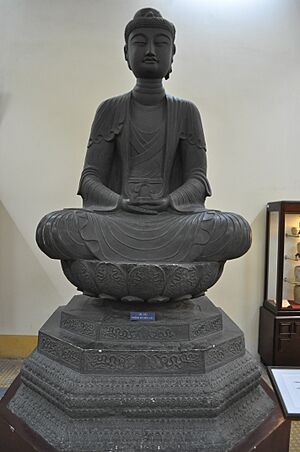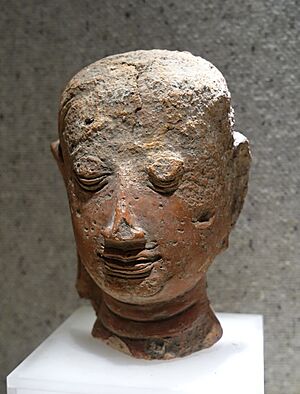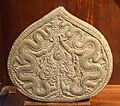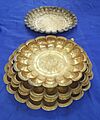Lý dynasty facts for kids
Quick facts for kids
Great Cồ Việt
大瞿越國 Đại Cồ Việt Quốc (1009–1054) Great Việt 大越國 Đại Việt Quốc (1054–1225) |
|||||||||
|---|---|---|---|---|---|---|---|---|---|
| 1009–1225 | |||||||||
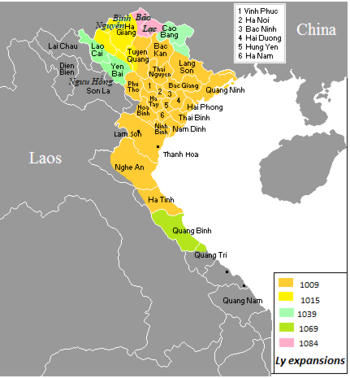
Territories of Đại Việt and expansion period
|
|||||||||

Administrative division of Đại Việt in 1085
|
|||||||||
| Status | Internal imperial system within Song tributary | ||||||||
| Capital | Hoa Lư (1009–1010) Thăng Long (1010–1225) |
||||||||
| Government | Monarchy | ||||||||
| Emperor | |||||||||
|
• 1009–1028
|
Lý Thái Tổ (first) | ||||||||
|
• 1054–1072
|
Lý Thánh Tông | ||||||||
|
• 1072–1128
|
Lý Nhân Tông | ||||||||
| Chancellor | |||||||||
|
• 1058
|
Lý Thường Kiệt | ||||||||
|
• 1069–1073
|
Lý Đạo Thành | ||||||||
|
• 1140–1158
|
Đỗ Anh Vũ | ||||||||
|
• 1158–1179
|
Tô Hiến Thành | ||||||||
|
• 1208–1211
|
Tô Trung Từ | ||||||||
|
• 1225
|
Trần Thủ Độ (last) | ||||||||
| Historical era | Medieval Asia | ||||||||
|
• Coronation of Lý Công Uẩn
|
21 November 1009 | ||||||||
|
• War with Dali kingdom
|
1014 | ||||||||
|
• Lý Thánh Tông changes the state name from Đại Cồ Việt to Đại Việt
|
1054 | ||||||||
|
• Lý–Song War
|
1075–1077 | ||||||||
|
• Lý Chiêu Hoàng abdicates, cedes throne to Trần Cảnh
|
1225 | ||||||||
| Currency | Copper-alloy cash coins | ||||||||
|
|||||||||
| Lý |
|||
|---|---|---|---|
| Country: | Kingdom of Đại Việt (Vietnam) | ||
| Titles: |
|
||
| Founder: | Lý Công Uẩn | ||
| Final Ruler: | Lý Chiêu Hoàng | ||
| Founding Year: | 10th century | ||
The Lý dynasty was a powerful Vietnamese ruling family that lasted from 1009 to 1225. It was first called Great Cồ Việt (Đại Cồ Việt) and later Great Việt (Đại Việt). This dynasty began when Lý Công Uẩn took over from the Early Lê dynasty.
The Lý dynasty ruled for 216 years. It ended when the young empress, Lý Chiêu Hoàng, gave up her throne to her husband, Trần Cảnh. During this time, Vietnam's official name became Đại Việt, which it kept for many centuries.
The Lý emperors were strong followers of Buddhism. However, ideas from Confucianism (from China) also became important. For example, the Temple of Literature was built in 1070 to honor Confucius. Later, Vietnam's first university, the Quốc Tử Giám, was opened there. This university first taught only the children of the emperor and important officials. The first imperial exam was held in 1075 to choose talented people for government jobs.
The Lý dynasty created a fair system of government based on laws. They moved the capital to a new city called Thăng Long (now Hanoi). This dynasty stayed in power because it had a strong economy and was popular with the people, not just because of its army. This was a new way of ruling for Vietnam. Many smart scholars and officials helped the dynasty succeed for over two centuries.
Contents
History of the Lý Dynasty
How the Lý Dynasty Began
In 1009, the last ruler of the Early Lê dynasty, Lê Long Đĩnh, died. He was not very popular. His son was too young to become emperor. So, important people at the court, like the official Đào Cam Mộc and the Buddhist monk Vạn Hạnh, decided to make General Lý Công Uẩn the new emperor of Đại Cồ Việt.
Lý Công Uẩn was born in 974 CE. When he was three, he was adopted by Lý Khánh Văn and took his family name. A wise Buddhist teacher, Vạn Hạnh, saw that Công Uẩn was a special and intelligent child. As he grew up, he joined the palace guards and became a commander. In 1009, Lý Công Uẩn became the new emperor, starting the Lý dynasty.
Moving the Capital City
-
Thiên đô chiếu (遷都詔), written in 1009 by Emperor Lý Thái Tổ when he decided to move from Hoa Lư to Đại La (later renamed Thang Long, as known as Hanoi today)
-
One Pillar Pagoda, built by emperor Lý Thái Tông in 1049
One year after becoming emperor, in 1010, Lý Thái Tổ decided to move the capital. He moved it from Hoa Lư to a place called Đại La, which he renamed Thăng Long. Today, Thăng Long is known as Hanoi. He wrote a special announcement, the Edict on the Transfer of the Capital, to explain why he was moving.
This decision was very important for Vietnam. It started a time of great growth and success for the Lý dynasty. Later dynasties also used Hanoi as their capital, and it is still Vietnam's capital today.
A Time of Trouble: The Three Princes
In 1028, Lý Thái Tổ passed away at age 55. Most of his officials expected his oldest son, Prince Lý Phật Mã, to become the next emperor. However, three of Lý Phật Mã's brothers disagreed. They were Prince Đông Chinh, Prince Dực Thánh, and Prince Vũ Đức. They attacked the imperial palace with their own armies to try and take the throne.
Lý Phật Mã found out about their plan. He ordered the palace gates to be closed and guards to protect it. But his advisor, Lý Nhân Nghĩa, told him to fight back. Lý Phật Mã sent Lý Nhân Nghĩa to lead the imperial army against his brothers. Lý Nhân Nghĩa won the fight and captured Prince Vũ Đức. The other two princes escaped. Lý Phật Mã then became Emperor Lý Thái Tông. He showed kindness to those who had opposed him and forgave his two brothers.
The Golden Age of the Lý Dynasty
During the reigns of emperors like Lý Thái Tổ and others, the Lý dynasty focused on making the country strong.
- Strong Government: The economy grew, especially farming. The government created the first law system in Vietnam, called "Hình thư." They also started an education system based on exams, similar to China's.
- Expanding Territory: The emperors tried to control more distant areas. They arranged marriages between princesses and local leaders to build stronger ties. If there were rebellions, the emperor would send princes to stop them.
- Protecting the Country: They solved small problems with the Song dynasty of China. They also fought against invasions from the Nanzhao and Champa kingdoms.
A big change happened in 1054 during the reign of Lý Thánh Tông. The country's name was officially changed from Đại Cồ Việt to Đại Việt. This name stayed for a long time.
During the Lý dynasty, the Vietnamese people began to expand southwards. This expansion was often into lands belonging to the Champa people. In 1069, the Champa Kingdom stopped paying tribute to Đại Việt. Emperor Lý Thánh Tông led an army against Champa. He captured their king, Rudravarman III. The Champa king had to give up two provinces, Quảng Trị and Quảng Bình, to Đại Việt. This greatly expanded Đại Việt's land. Champa also had to start paying tribute again.
The Lý Emperors helped improve farming by building and fixing dikes and canals. They also let soldiers go home for six months each year to work on their farms. As their land and population grew, the Lý Emperors looked to China for ideas on how to organize a strong government.
In 1070, Lý Thánh Tông ordered the building of the Imperial Academy and the Văn Miếu Temple. These places helped improve education. In 1075, officials were chosen by examination for the first time. A training school for civil servants was set up in 1076. By 1089, there was a clear system of government officials, with different levels for scholars and military leaders. Exams became required for public jobs, and writing contests helped decide officials' ranks.
Emperor Lý Thánh Tông died in 1072. His young son, Càn Đức, became Emperor Lý Nhân Tông at age 7. His mother, Concubine Ỷ Lan, became the regent (someone who rules for a young king). She later took full control of the regency with the help of Chancellor Lý Thường Kiệt.
In the 1050s, there was growing tension between Đại Việt and the Song dynasty of China. In 1075, a Song official suggested invading Đại Việt. This made Emperor Lý Nhân Tông decide to attack Song territory first. Lý Thường Kiệt led an army and captured several Chinese cities. One city, Yongzhou, fell in 1076. The Song dynasty then sent a large army to invade Đại Việt. But Lý Thường Kiệt stopped them at the Battle of Như Nguyệt in 1077. After this, the Song and Đại Việt made a peace treaty.
Challenges and Changes in Leadership
Emperor Lý Nhân Tông ruled for a very long time. He had no children of his own, so he adopted his nephew, Lý Dương Hoán, to be the next crown prince. Lý Nhân Tông died in 1128. Lý Dương Hoán became Emperor Lý Thần Tông at age 11. This marked a change in the royal family line. Lý Thần Tông ruled for 10 years before he died young. His son, Lý Thiên Tộ, became Emperor Lý Anh Tông at just 3 years old.
Thần Tông's wife, Empress Cảm Thánh, became the regent. Her close friend, Đỗ Anh Vũ, gained a lot of power in the court. Other officials and royal family members did not like this and tried to arrest him. However, the empress helped him, and he was not killed. He was sent away for a while but later returned to power. He took revenge on those who had tried to arrest him. Emperor Lý Anh Tông had to agree to this. Đỗ Anh Vũ died in 1158. Tô Hiến Thành, a relative of Anh Vũ, later became the chancellor. Unlike Anh Vũ, Tô Hiến Thành was very loyal to the Lý court. He was skilled in leading successful military campaigns against Champa and Lan Xang.
In 1174, Lý Anh Tông's oldest son, Lý Long Xưởng, lost his right to be crown prince because of bad behavior. His younger brother, Lý Long Cán, became the new crown prince. In 1175, Emperor Anh Tông died at age 40. The young Lý Cao Tông became emperor at three years old. Tô Hiến Thành again became the regent and teacher for the young emperor.
After Tô Hiến Thành died in 1179, other officials took over as regents. Emperor Lý Cao Tông allowed rich people to buy high-ranking government jobs. This led to problems in the country. He also spent a lot of money on luxurious palaces, which made the people angry and caused rebellions.
Rebellions and Civil War
The Quách Bốc rebellion was a major event that weakened the Lý dynasty. In 1207, a governor named Đoàn Thượng started a revolt. The emperor sent generals to stop it. However, Đoàn Thượng managed to corrupt one of the generals, Phạm Du, who then tricked the emperor into pulling back his soldiers.
Phạm Du was later sent to train the military, but he started recruiting criminals for his own plans. The emperor sent another general, Phạm Bỉnh Di, to capture Phạm Du. Phạm Du lost the battle and ran away. In 1209, Phạm Bỉnh Di won against the rebels. The emperor called Phạm Du back to the capital. But Phạm Du lied and blamed Phạm Bỉnh Di. Emperor Cao Tông believed Du and ordered Phạm Bỉnh Di and his son to be captured. When their leader was captured, Quách Bốc, a general under Bỉnh Di, attacked the palace to rescue him. Emperor Cao Tông had Bỉnh Di and his son killed and then fled. Quách Bốc captured the palace and made Prince Lý Thầm the new emperor.
Prince Lý Hạo Sảm, another royal prince, fled with his mother. They met the leader of the Trần family, Trần Lý, and general Tô Trung Từ. Both supported Lý Hạo Sảm as emperor. Lý Hạo Sảm then married Trần Lý's daughter, Trần Thị Dung. Emperor Lý Cao Tông tried to fight back but failed to get his throne back. Finally, Trần Lý led his army against Quách Bốc and ended the rebellion. However, the Đại Việt kingdom was now split among many powerful warlords.
In 1210, Lý Cao Tông died. Lý Hạo Sảm became Emperor Lý Huệ Tông. General Tô Trung Từ gained too much power and was killed by other officials. His nephew, Trần Tự Khánh, gathered an army and threatened the capital. Emperor Huệ Tông asked for help from the warlord Đoàn Thượng, who had rebelled earlier. But they were defeated by Tự Khánh. The emperor had to escape.
In 1214, Trần Tự Khánh's forces took back the capital. He made Emperor Lý Nguyên Hoàng a puppet ruler. At the same time, another warlord, Nguyễn Nộn, attacked the capital and burned all the palaces. This forced Tự Khánh and Emperor Nguyên Hoàng to move. The country was again divided by many warlords.
By late 1214, Trần Tự Khánh's forces retook the capital and slowly defeated the other warlords. By the end of 1220, most of the smaller warlords were under control.
The Rise of the Trần Family
In late 1216, Trần Thị Dung was made Empress. Members of the Trần family were given important jobs in the court. Trần Tự Khánh became chancellor, his brother Trần Thừa became a Marquis, and Trần Thừa's son Trần Liễu became a Prince.
In 1217, Emperor Lý Huệ Tông became very ill and mentally unwell. He often acted strangely. By this time, most government matters were handled by Chancellor Trần Tự Khánh, not the emperor. The Trần family slowly gained more and more power. In 1223, Chancellor Trần Tự Khánh died. Trần Thừa took his place and received even more power from the emperor.
The End of the Lý Dynasty
Emperor Huệ Tông did not have a son to be his heir. So, Captain Trần Thủ Độ (Trần Thừa's cousin) decided that the emperor's second daughter, Princess Chiêu Thánh, would become the Queen of Đại Việt. In 1224, Huệ Tông gave the throne to his daughter. Lý Chiêu Hoàng, at only 6 years old, became the first reigning queen of Vietnam.
Trần Thủ Độ took control of all daily court matters. He brought his nephew, Trần Cảnh (Trần Thừa's second son), to be a close friend of the young Queen. They became very close. To overthrow the Lý dynasty, Trần Thủ Độ arranged for them to marry the next year. Trần Cảnh later became the Queen's husband. In 1226, Trần Thủ Độ forced Lý Chiêu Hoàng to give the throne to Trần Cảnh. Trần Thừa became the Regent Retired Emperor. The Lý dynasty officially ended, and the Trần family took over. The former emperor Huệ Tông was forced to take his own life. In 1232, many members of the Lý royal family were killed by Trần Thủ Độ. The Lý dynasty was no more, and the Trần dynasty officially began.
After the Lý dynasty fell, some members of the royal family escaped to Korea. They became generals in the Goryeo dynasty there.
Government System
At the top level of government, under the king, were the "Thái" positions. These included three top officials for writing and learning (like a prime minister) and one for military affairs. Below them were "Thiếu" positions, which were slightly lower ranks.
Administrative Divisions
In 1010, Lý Thái Tổ changed the country's 10 main regions into 24 "lộ." A "lộ" was then divided into smaller areas called "châu" (in mountains) or "phủ" (in lowlands). These were further split into "huyện" and "giáp," and then into "hương" and "ấp," which were like villages.
Laws and Justice
During the Lý dynasty, laws were mainly based on the emperor's announcements. There were also written laws for civil matters, crimes, lawsuits, and marriage. Because the Lý rulers were strong Buddhists, punishments during this time were not very harsh.
Foreign Relations
The Lý dynasty traded with China, the Dali Kingdom, and other kingdoms in Southeast Asia.
Relations with the Song Dynasty
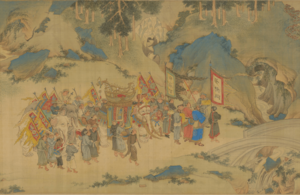
In its relations with the Song dynasty of China, Vietnam acted like a smaller state that paid tribute. However, at its strongest, Đại Việt even sent troops into Chinese land to fight the Song during the Lý–Song War.
In 1016, the Song emperor gave Lý Công Uẩn the title of "King of Giao Chi." This was the first time the Song dynasty returned gifts to a Vietnamese king, showing they recognized the Lý dynasty's power. The Song dynasty also sent officials to attend the funeral of a Vietnamese king for the first time during the Lý dynasty.
Tensions between the Lý and Song grew during the reign of Lý Nhân Tông (1072–1128). His army captured several Chinese cities along the border after attacking Champa. In 1075, a Song official told the Song emperor that Đại Việt was weak after a defeat by Champa. This led to the Lý-Song War, where the Song launched an invasion that failed. The conflict ended after Lý Nhân Tông sought peace following his military successes.
During the time of Lý Anh Tông (1138–1175), the Song dynasty changed Vietnam's name from "Jiaozhi" to "Annan."
Relations with the Jin Dynasty
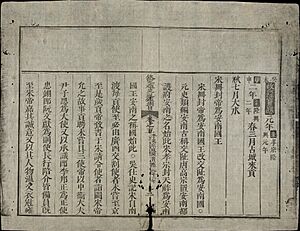
In 1168, the Jin Emperor Shizong sent a messenger to Thăng Long to start a relationship. Both Jin and Song messengers visited the Lý court at the same time. But Emperor Lý Anh Tông made sure they did not meet to avoid problems.
Relations with the Dali Kingdom
In 1013, a local leader named Hà Trắc Tuấn, who was allied with the Dali kingdom, rebelled against the Lý government. Dali forces and Tuấn's tribal supporters invaded Đại Cồ Việt in spring 1014. Reports say Dali and rebel forces had about 30,000 soldiers. They occupied a province and waited for the Lý army. Lý Thái Tổ sent an army and defeated the rebels. A Dali general was captured. Peace returned to the mountainous border for several years.
Relations with Champa
The Lý dynasty had trade relationships with Champa. They also fought two major battles against Champa in 1044 and 1069.
Religion in the Lý Dynasty
The main religion of the Lý dynasty was Buddhism. The first Lý emperor was a Buddhist monk, and Buddhist leaders supported him. Lý emperors helped fund and support Buddhist temples and monks. Buddhism became the official religion. Members of the royal family and nobles visited temples, helped build pagodas, and sometimes even became monks or nuns. The kingdom was run according to Buddhist ideas and laws. Emperors built pagodas to celebrate military victories, like when Lý Thường Kiệt defeated the Song. The Bao An pagoda was built to thank the Buddha.
Besides Buddhism, the emperors also took part in other religious ceremonies. These involved local spirits and gods like Indra and Brahma. Shrines were built to honor important figures like the Trung sisters. Monks and nuns became a special group who did not have to pay taxes or serve in the army. An old stone carving from 1209 shows that the emperor gave a lot of land to the clergy (religious leaders) and for spiritual festivals. Other carvings also show how important Buddhism was to the monarchy and Vietnamese society.
Fashion and Style
Nobility and Court Dress
The Emperor wore a golden robe and purple trousers. His hair was tied in a bun with a golden pin. Court officials and nobles wore dark tunics with four flaps, a high collar, and dark trousers. Their hair was also in a bun with an iron pin. They wore black gauze head coverings and peaked caps. They also wore leather sandals and carried fans made of stork feathers.
Military uniforms included a cap that covered the ears, a knee-length tunic, and tight sleeves. The tunic was covered with small armor plates that had spiral designs or large flower patterns. Some uniforms had bells, fringes, and tiger-face designs. The fabric often had a tiled or scaled pattern. A cloth waistband was tied around the waist. Leather waistbands were worn tightly to show body muscles. Boots reached up to the knee and were simply decorated.
Female dancers wore their hair in a "skyward" bun with decorative fringes on the forehead and flowers. They wore bracelets, necklaces, and short, pleated skirts. Musicians had unique costumes. They wore a cap that covered their hair, with a high, zigzag top. Their inner shirts had long, tight sleeves. Over this, they wore a short-sleeved shirt with special shoulder designs. They had wide, embroidered cloth strips around their waists. They wore leggings on their calves and pointed-toe canvas shoes.
Tattooing was still a common practice during this period, especially for the King and his soldiers. Imperial Guards had special marks tattooed on their chests and legs, including dragon patterns. Like in earlier times, they would tattoo the words "Thiên tử quân" (meaning "Emperor's Army") on their foreheads. The armor of military leaders was also decorated with bells. This showed national pride and the continuation of old traditions.
A special statue from this time, the Buddha Amitabha statue at Phật Tích Pagoda, shows very detailed clothing. The robe has curved, straight, and zigzag folds that make it look like it's moving. The pleats look like lotus leaves and fit closely to the body. They flow like a stream or waves, showing that the robe was wide and made of smooth, delicate fabrics. The inner garment had a wide collar and wide sleeves. The waistband was tied in a figure-eight shape with straps hanging down.
Chronicle
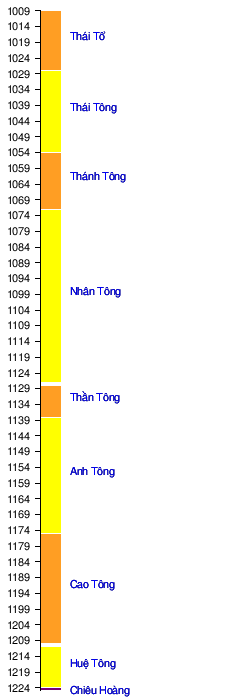 |
| Thái Tổ | |||||||||||||||||||||||||||||||||||||||
| Thái Tông | |||||||||||||||||||||||||||||||||||||||
| Thánh Tông | |||||||||||||||||||||||||||||||||||||||
| Nhân Tông | Sùng Hiền hầu | ||||||||||||||||||||||||||||||||||||||
| Thần Tông | |||||||||||||||||||||||||||||||||||||||
| Anh Tông | |||||||||||||||||||||||||||||||||||||||
| Cao Tông | |||||||||||||||||||||||||||||||||||||||
| Huệ Tông | |||||||||||||||||||||||||||||||||||||||
| Chiêu Hoàng | |||||||||||||||||||||||||||||||||||||||
Images for kids
See also
- List of emperors of the Lý dynasty


